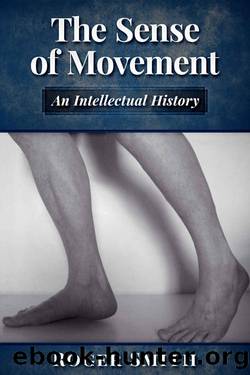The Sense of Movement: An Intellectual History by Roger Smith

Author:Roger Smith [Smith, Roger]
Language: eng
Format: epub
ISBN: 9781899209231
Publisher: Process Press Ltd
Published: 2019-08-11T21:00:00+00:00
âConsciousness is essentially motor or impulsiveâ â this made sensory awareness of movement of central significance. It made it part of a reorientation of psychology, for which Dewey was a leading spokesman, escaping from a sterile (overly intellectual) interest in what people know into a brave new world of (practical) understanding of what people do. New experimental studies of perception, cognition, attention and action alike had to take account of kinaesthesia, the sensory process inherent to coordinated âdoingâ. Arguing in this vein, Charles H. Judd, in 1905, stated: âSome of the most promising constructive work in recent psychology has been along the lines of substituting a thorough-going recognition of the importance of the motor conditions of consciousness for the one-sided sensation theories of earlier days.â10
There was significant experimental research on volition early in the twentieth century.11 It was not the case that âthe new psychologyâ simply threw out volition as a category belonging to an unscientific age. If there was a decline in references specifically to volition in the psychological literature, this was evident only in the United States.12 Even in this setting, though, the interest in understanding cognition as activity, a âdoingâ, evident in psychology in the first two decades of the century, sustained a way of talking about kinaesthesia and effort in connection with âwillfulâ subjects.
It is necessary to say something about the topic of attention in order to understand this connection. The attempt to construct approaches to volition in terms open to disciplined experimental research and analytic study (in philosophical psychology) was responsible, at least in part, for the great contemporary interest in attention. As the influential US psychologist, W. B. Pillsbury, stated in 1908, this was a route by which psychologists hoped to do justice to the active psychological world while escaping from the metaphysical conundrums references to will summoned up. Surveying the topic, he attributed what he perceived as âthe present chaotic condition of attention theoriesâ to widespread, popular confusion of notions of willful effort with attention.13 Bain, for example, had posited an elementary awareness of activity in movement, but was this a reference to attention, effort, strain, volition or sensed movement?14 Pillsbury cited researchers who aimed to render attention âsomething more definite than the will of popular speech or its scientific counterpart the will of a faculty psychologyâ but who nevertheless were âleft with an indefinite idea of a force of an unknown kindâ.15
This was the challenge to science: to specify the nature of mental activity without reverting to what was felt to be the pre-scientific language of âthe willâ or to âan indefinite idea of a forceâ. Pillsbury roundly criticized personifications of active consciousness (which, he wrote, are ârooted in the anthropomorphic tendencies of the human mindâ) and looked to the study of factors focusing a personâs attention, that is, to social norms and habits, to explain volition: âWill is no thing or force, but merely a convenient term to designate the fact that the early and general social influences hold attention, thought and action toward the things that are permanent rather than to those things that are transient.
Download
This site does not store any files on its server. We only index and link to content provided by other sites. Please contact the content providers to delete copyright contents if any and email us, we'll remove relevant links or contents immediately.
| Anthropology | Archaeology |
| Philosophy | Politics & Government |
| Social Sciences | Sociology |
| Women's Studies |
The remains of the day by Kazuo Ishiguro(7551)
Tools of Titans by Timothy Ferriss(6949)
The Black Swan by Nassim Nicholas Taleb(6192)
Inner Engineering: A Yogi's Guide to Joy by Sadhguru(5897)
Giovanni's Room by James Baldwin(5879)
The Way of Zen by Alan W. Watts(5800)
The Six Wives Of Henry VIII (WOMEN IN HISTORY) by Fraser Antonia(4791)
The Power of Now: A Guide to Spiritual Enlightenment by Eckhart Tolle(4756)
Astrophysics for People in a Hurry by Neil DeGrasse Tyson(4620)
Asking the Right Questions: A Guide to Critical Thinking by M. Neil Browne & Stuart M. Keeley(4576)
12 Rules for Life by Jordan B. Peterson(3734)
The Ethical Slut by Janet W. Hardy(3504)
Skin in the Game by Nassim Nicholas Taleb(3462)
Housekeeping by Marilynne Robinson(3402)
The Art of Happiness by The Dalai Lama(3385)
Double Down (Diary of a Wimpy Kid Book 11) by Jeff Kinney(3274)
Skin in the Game: Hidden Asymmetries in Daily Life by Nassim Nicholas Taleb(3264)
Walking by Henry David Thoreau(3234)
12 Rules for Life: An Antidote to Chaos by Jordan B. Peterson(3204)
